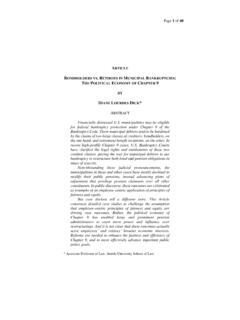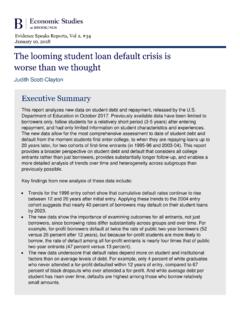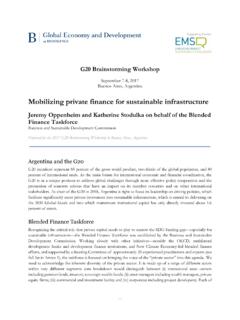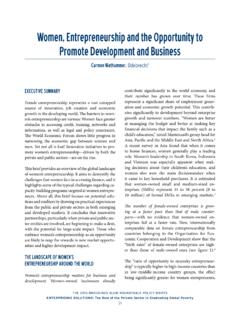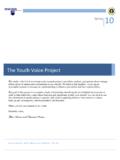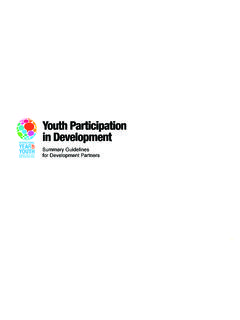Transcription of Youth Internet Safety: Risks, Responses, and …
1 1 Youth Internet safety : risks , Responses, and Research RecommendationsAdina Farrukh, Rebecca Sadwick, and John VillasenorI. IntroductIonAs Internet use by children and teenagers increases, so do concerns about their online safety . Providing a safe environment requires an in-depth understanding of the types and prevalence of online risks young Internet users face, as well as of the solutions most effective in mitigating these risks . Despite the very significant amount of research that has been conducted regarding these risks , improving child/ Youth Internet safety remains a challenge. In part, this is because definitions of terms and categories relevant to online safety (such as cyberbullying ) often vary, making the comparison of statistics and findings among sources imprecise. In addition, there are complex overlaps among different online safety subtopics. Overall, these factors can make identifying the specific gaps in existing research and knowledge difficult.
2 If these gaps can be better identified and filled, a data-based understanding of issues facing Youth could play a key role in driving policy decisions regarding online safety . To address this issue, the present paper aims to provide 1) an overview of existing online safety research across a wide range of categories, 2) an analysis of major findings, 3) an identification of knowledge gaps, and 4) a set of recommendations for specific areas of research that can further the policy dialog regarding online safety . II. chIld/ Youth Internet safety : a category-based approachThe appendix on page twelve lists the over 50 publications that were considered in this study. For each publication, we identified the relevant online safety category (or, in many cases, categories), as well as the country where the study was primarily performed, and other relevant information. We then integrated the results on the basis of the categories identified farrukh, a former elementary school teacher, is currently a graduate student in public policy at the UCLA Luskin School of Public Affairs, and a researcher at the UCLA Luskin Center for work that led to this paper was performed at the Luskin Center for Innovation in the UCLA School of Public Affairs, with support from Google.
3 The authors thank Anne Collier and Larry Magid, Co-directors of , for valuable advice during this sadwick is a researcher at the UCLA Luskin Center for Innovation. Her past work includes studying the impact of teacher tenure and merit-based pay on America s achievement gap through the Center for American Politics and Public Villasenor is a nonresident senior fellow in Governance Studies and the Center for Technology Innovation at Brookings. He is also a professor of engineering and public policy at UCLA. During fall 2014, he is a National Fellow at the Hoover Institution at 2014 Youth Internet safety : risks , Responses, and Research Recommendations 2 CyberbULLyInG VARYING DEFINITIONS. Some instances of cyberbullying are clearly identifiable, given the language and tactics used to harass and/or intimidate a victim online. Given the range of problematic/harmful behaviors involved, however, it can sometimes be difficult to pinpoint when an action crosses the line from poor conduct to a more serious and possibly criminal Nevertheless, researchers generally characterize cyberbullying as actions using a technological medium to intimidate or convey an intent to harm.
4 The communication often involves repetition of actions, and a power imbalance between the victim and In discussions of cyberbullying, repetition implies that the communication is repeated and harm is intention-ally inflicted it is not typically an isolated, one-time Power imbalance broadly refers to the dynamic that gives a bully power over the victim(s). In traditional, in-person bullying, power imbalance often comes in the form of physical strength, size, or other strategic advantage. In Internet bullying, power imbal-ance can be conceptualized in a variety of ways. For example, a bully might possess a greater familiarity with the Internet than does the victim. The bully is also able to preserve anonymity: physical strength is not necessary to maintain power, as a cyberbully is able to shield his or her identity from the victim(s) for a prolonged period of time. 4 This ability to conceal one s identity can also lead to cyberbullying by people who might not have engaged in bullying in traditional contexts.
5 Additionally, the fact that content in cyberspace is difficult or impossible to delete can also contribute to a victim s feelings of powerlessness or humiliation, which can sometimes deter them from seeking help from an There are many similarities between the motives and natures of traditional bullying and cyberbullying. Some researchers point to the offline presence of many of the same risks Youth face on the Internet . For example, there is often a nexus between school bullying and cyberbullying. 6 The strong overlap in motives between traditional in-person bullying and cyberbullying namely in seeking revenge and wielding power has led many researchers to suggest implementing school and community-wide strategies to address the underlying climate and causes of peer bullying. Bullying might start offline and continue online or vice versa, though in some cases cyberbullies and victims do not know each other in the offline world. School and community-based initiatives to improve the relationships and attitudes Youth have with and toward each other are thought of as potentially effective prevention measures, though more research on which particular programs and strategies are most effective is still Sabella, R.
6 A., Patchin, J. W., & Hinduja, S. (2013). Cyberbullying myths and realities. Computers in Human behavior, 29(6), (Sabella et al, 2013).3 Slonje, R., Smith, P. K., & Fris n, A. (2013). The nature of cyberbullying, and strategies for prevention. Computers in Human behavior, 29(1), (Slonje et al, 2013). 5 (Slonje et al, 2013). 6 Magid, L. (2013, Nov 11). Preventing and recovering from bullying what works and what doesn t. Retrieved from (Magid, Nov. 2013). In Internet bullying, power imbalance can be conceptualized in a variety of ways. For example, a bully might possess a greater familiarity with the Internet than does the Internet safety : risks , Responses, and Research Recommendations 3 preValence. Different studies on cyberbullying tend to produce varying statistics. There is a lack of clear con-sensus regarding the prevalence of cyberbullying, especially when compared to traditional bullying. In addition, there is limited evidence regarding growth of cyberbullying, and whether (and the extent to which) it may partially replace offline bullying.
7 Differing definitions and survey methodologies used by researchers also contribute to the lack of consensus between statistics produced by different studies. For example, researchers report figures on the percent of Youth who have been victims of cyberbullying that can be as high as 72 percent or as low as 4 While most studies tend to report figures between 6 percent and 30 percent,9 developing a more longitudinal survey method, based on a more standardized definition of cyberbullying, would make studies less susceptible to differences in perception and interpretation among This is especially true given the fact that Youth (and some researchers) inter-pret the term bullying differently, making it more difficult to develop consistency in analyzing their responses to surveys about online scholars caution against any use of the word bully or cyberbully, especially in schools. They favor use of the word victimization, which can describe more types of negative behaviors to be immediately addressed by school and community Given recent media and community-awareness efforts, the word bully carries, for many children, a connotation that includes every imaginable mean behavior from the rolling of eyeballs to not wanting to be your friend, to sexual assault.
8 13 Dorothy Espelage of the University of Illinois has written that the overuse of the word bully has really obscured our ability to focus on what s happening to children. 14 The term is often misapplied to actions or behaviors that are normative, or part of being a human being (such as saying something mean when angry, or making an honest mistake that one later regrets). 15 Characterizing all negative behavior as bullying can deter children from seeking adults help if they fear the adult will overreact and exacerbate the issues by drawing unwanted attention. This is often the case when adults mistakenly attribute behavior that isn t serious and actionable to That said, behaviors that may not fit a specific bullying definition ( , that may fall outside the particular definition of bullying in a school policy) could nonetheless warrant intervention, which is further reason that some researchers suggest attributing negative behaviors to victimization. 17 MotIVes.
9 The reasons perpetrators choose to cyberbully tend to vary. However, revenge for perceived wrong-doing is frequently cited among Youth who have admitted to cyberbullying others. Cyberspace has become a new forum for bullying by people who might be too afraid or weak to commit bullying in traditional ways that would 8 Kowalski, R. M., & Limber, S. P. (2013). Psychological, physical, and academic correlates of cyberbullying and traditional bullying. Journal of Adolescent Health, 53(1), (Sabella et al, 2013). 10 Vandebosch, H., & Van Cleemput, K. (2009). Cyberbullying among youngsters: Profiles of bullies and victims. new Media & Society, 11(8), 1349-1371. 11 (Sabella et al, 2013).12 Collier, A. (2013, June 4). Stop Using the Word bullying in School, researchers Say. Retrieved from (Collier, June 2013).14 Toppo, G. (2013, May 1). researchers: Stop Using the Word bullying in School. Retrieved from (Collier, June 2013).16 (Collier, June 2013).
10 17 (Collier, June 2013). Youth Internet safety : risks , Responses, and Research Recommendations 4make them more easily Young cyberbullies also cite the ability to preserve anonymity and reach wider audiences as reasons they began victim-izing other Youth online. Importantly, because anonymity can often be preserved and only the most basic understanding of the Internet is necessary to engage in cyberbullying, young cyberbullies do not yet have a set of clearly defined Any young person from the straight-A student to the class clown might be a cyberbully. preVentIV e/copIng strategIes. The more basic preventive strategies (which can be employed within the broader context of Internet safety as well) include:20 encouraging Youth not to disclose any identifying information online utilizing IP addresses to track and block problematic visitors switching online user accounts if harassment begins. Like traditional bullying, cyberbullying among peers can be placed within a broader social context.

